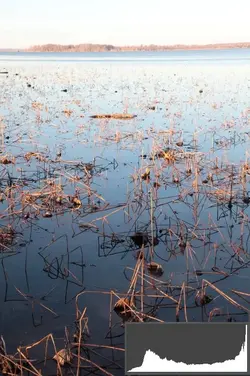First: Hoping for the best with the new baby!
Second: You're talking about the histogram displayed by the camera. Whenever you talk about the histogram displayed by the camera you have to include a critical qualification:
The camera histogram does not provide direct data about the exposure of the camera sensor. This is really important. The histogram the camera displays is derived from the JPEG file processed by the camera software.
If you're shooting JPEGs and the camera JEPG is your final goal, then you can look at that histogram and consider the data displayed as valid.
HOWEVER if you are shooting and saving the raw files then that histogram really isn't giving you directly accurate information. When discussing the camera displayed histogram you gotta make it clear whether you're goal is a camera JPEG or raw capture. The histogram only directly applies to the camera JPEG.
An example:

That's the camera JPEG -- SOOC. I've inset the histogram for that photo (Photoshop). The histogram displayed by the camera would have appeared much the same. Based on that histogram it's fair to say the highlights are blown and the photo is overexposed. Looking at the photo of course the highlights are blown. There was color and clouds in the sky and I'm not seeing them in this photo.
Here's the histogram of the raw file that was saved for that photo:

And in fact the highlights are not blown and the photo is not overexposed and there's actually room for a smidge more exposure. The camera will not give you a histogram for the exposure of the sensor. It will only give you a histogram for the software processed JPEG. CAVEAT: In all fairness I didn't make any attempt to modify the camera's JPEG output because I couldn't care less what it does. Had I done that by applying an image adjustment contrast reduction this example could be less extreme. But the point stands; the histogram on the camera isn't telling you directly what you've got in the raw file.
So I saw color and clouds in the sky and I photographed color and clouds in the sky. Even though the camera histogram would have told me I'd blown it (I don't bother to look), I knew I hadn't.
Joe

P.S. I know about UNIWB and don't consider that a viable option, especially since I really don't need it -- I have a light meter.





![[No title]](/data/xfmg/thumbnail/41/41784-8cbc2bbf42c1ea67cfe2f77fdd5c53ec.jpg?1734176089)

![[No title]](/data/xfmg/thumbnail/37/37604-7ad625e983f92f880eb65a264eeef5e4.jpg?1734170732)
![[No title]](/data/xfmg/thumbnail/32/32702-7344d6e6132276dd7bfc046084fea432.jpg?1734162266)


![[No title]](/data/xfmg/thumbnail/37/37605-90c8efaef5b7d1f52d4bf8e7dfd33673.jpg?1734170732)



